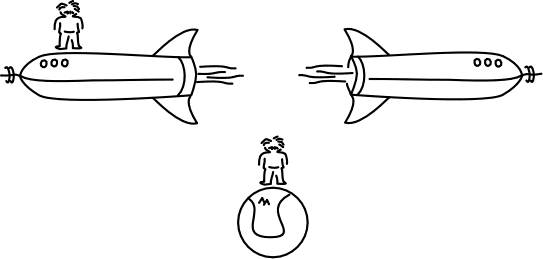Problem: When two moving space ships pass each other in space, why do they BOTH see the other's clocks as moving slower?
Here's how Wikipedia's article on Time Dilation describes the "problem":
When two observers are in relative uniform motion and uninfluenced by any gravitational mass, the point of view of each will be that the other's (moving) clock is ticking at a slower rate than the local clock. The faster the relative velocity, the greater the magnitude of time dilation. This case is sometimes called special relativistic time dilation.It is understood that people aboard space ships going at high velocities will view everything moving at "normal" speeds aboard their own ship. I.e, their clocks will appear to be ticking and measuring time "normally."
For instance, two rocket ships (A and B) speeding past one another in space would experience time dilation. If they somehow had a clear view into each other's ships, each crew would see the others' clocks and movement as going more slowly. That is, inside the frame of reference of Ship A, everything is moving normally, but everything over on Ship B appears to be moving more slowly (and vice versa).
If there are two space ships, the people on both ships will view their own clocks as operating "normally."
In a situation where there is only one space ship, a person aboard that space ship would see a clock next to a stationary person on earth as moving faster. (However, this may be viewing Time Dilation without the "special relativistic" factor.)
In a situation where two space ships are moving in parallel at the same speed, they would all view each other's clocks as all working "normally."
So, the question is: When the two space ships are not in synchronous movement, why do they see the other space ship's clocks as moving slower regardless of what speeds or directions they are moving?
Another question: If people aboard a moving space ship see clocks that are stationary as moving faster, why doesn't the crew of a fast moving ship see the clocks on a slow moving ship as moving faster?
It seems the answer must be in what is perceived versus what is actually happening. The person doing the viewing perceives time as "normal" and they perceive time on the other ship as moving slower. This subject is typically illustrated with clocks that bounce light beams up and down off mirrors.
A person beside such a clock will perceive light going straight up and down, which is "normal." They will perceive the light beams on the clocks on the other ship as moving at angles, tracing out longer V or W patterns as the ship moves relative to the observer. Since the speed of light is fixed, longer paths for the light beam means slower time.
However, there seems to be no way to perceive time as moving faster when bouncing light straight up and down perceived as "normal" and light bouncing at angles is perceived as "slower."
Is that why light-based clocks are used? It it a purely hypothetical Relativistic situation that is dependent entirely on using light based clocks?
Or is there some way to relate this to mechanical clocks? Why would mechanical clocks on the other ship also be perceived as running slower? Why wouldn't mechanical clocks on the slower ship be perceived as running faster?
The best description I've seen of light-based clocks can be viewed by clicking HERE. It also describes why mechanical clocks would work just like light-based clocks when they are side by side. Here's the illustration they use at the section about this:
But I still do not understand why the mechanical clock on the slower moving space ship would not be perceived as running faster than the clock on the faster moving space ship.
And, it seems to me that if I'm aboard a fast moving space ship and we pass a slower moving space ship on the left side of my ship, the slow ship will pass moving right to left, and the light beam clock would create a V moving from left to right. If I am aboard a slow moving space ship and a faster moving space ship passes me on the left, the ship will move from left to right, and the movement of the bouncing light beam would create a V moving right to left.
There should be some way to translate the left to right creation of the V on the slower ship's clock as an indicator that the clock on that slow ship I passed is running fast.
What is it I am not understanding?
I suspect that, while I understand Time Dilation very well, I am not understanding Special Relativity and Special Relativistic Time Dilation. I suspect that Special Relativity is best described using mathematics. I suspect Special Relativity involves things in the mathematical realm that are counter intuitive to human visual experiences and therefore cannot be easily described in human experience terms. I suspect that is why, when teachers try to describe aspects of Special Relativity in visual terms, their descriptions make little sense to people who do not know and understand the mathematics. They are "counter intuitive." That is probably why teachers are always apologizing and telling their students that it would all make more sense if they studied the mathematics.
Ed



No comments:
Post a Comment